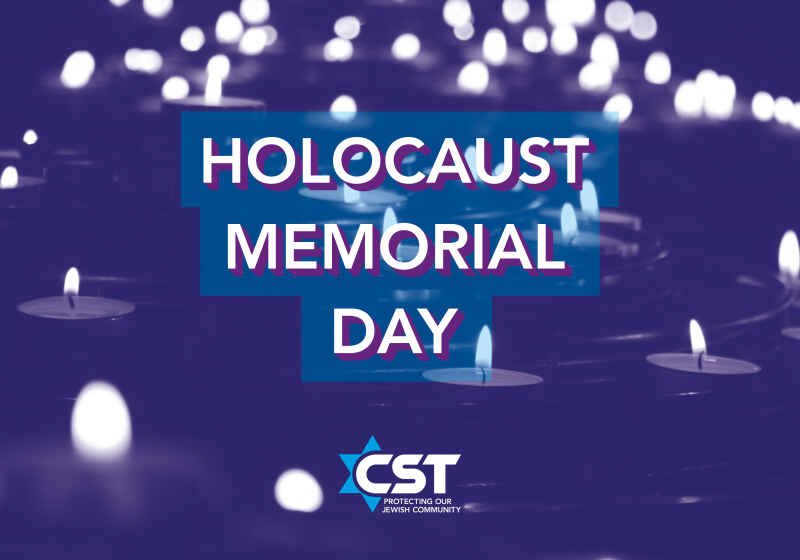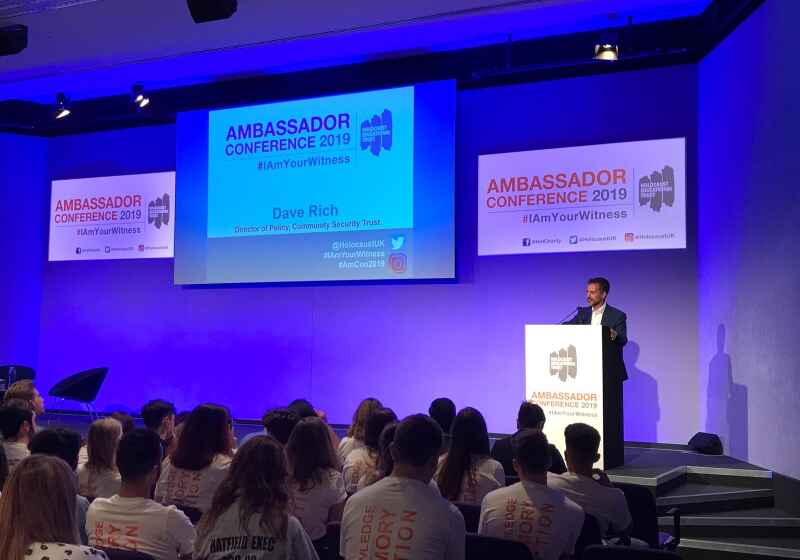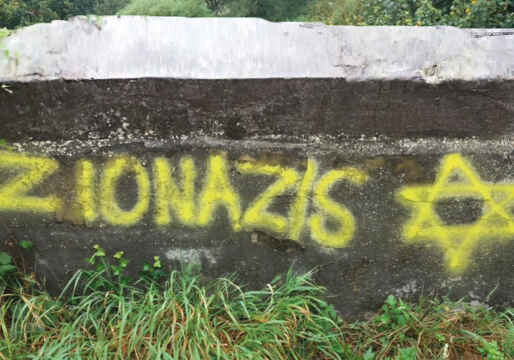CST Blog
Eyewitness account of the beginning of the liquidation of the Warsaw ghetto
8 May 2016
To mark today’s commemoration of Yom Hashoah, please see the below reflection by Yoni Zlotogorski; and the profound eye-witness account by his maternal grandfather Morris of the liquidation of the Warsaw Ghetto.
Yoni is Head of Policy and Research in the Jewish Leadership Council. CST thanks him for having permitted us to share this personal memoir with all of you:
Yom HaShoah is upon us.
As it is no doubt for many of you, it is a deeply personal day for me. My four grandparents survived the Holocaust. My paternal grandparents, Abe and Miriam, survived Auschwitz-Birkenau. My maternal grandmother, Helen, was hidden and saved by her Christian neighbours, who rightfully were later declared חסידי אומות העולם - Righteous Among the Nations. Finally, my maternal grandfather, Morris, survived the Warsaw ghetto, as well as 9 concentration and death camps including Majdanek, Plaszow and Theresienstadt.
During the time I had the privilege of working for Israel's previous Ambassador to the UK Daniel Taub, he used a remark that we are reaching a point where - as survivors move on to the next world - the Shoah will cease to become memory and becomes only history. For my family this has now become a reality. My maternal grandfather, Morris Wyszogrod, passed away last year at the age of 95. He was the last of the survivors in my family.
This is why I wanted to remember my grandparents, their family members who were murdered in the Shoah, and all 6,000,000 victims by keeping alive a short text. Written originally in Yiddish by Morris in Paris in 1947, it tells of the liquidation of the Warsaw ghetto from his own eyes. He was a slave labourer at the time working off-site at a nearby German airfield.
I wish you all a meaningful Yom HaShoah and thank you for reading.
May their memory be a blessing to us all.
Shma Yisroel
By Morris Wyszogrod, Paris, Spring 1947
Over ruins, fields, valleys, and cemeteries, the death-cries of a nation can be heard. The wind carries the sad echo on its frenzied dance among the graves and the weeds that surround them. I hear the holy screams and see the images of brothers and sisters taking their last steps to die in God’s name, al Kiddush Hashem.
The day was gruesome, and even more gruesome was the night. The last blood-red rays of the sun flooded the earth of the old Jewish cemetery. In the red light, the black contours of the gravestones were moving, as though everything here was alive. This was the place that the Angel of Death chose for his simcha, his celebration. And when the bloody rays began to fade and the sun sank deeper and deeper, the sky reflected these surroundings in the twilight and everything went pale, as though the stones and everything around them trembled at what would happen next.
The mood in the cemetery reflects the mood in the ghetto. There, behind the heavy wall, a nation, near death, sighs, convulses. The Angel of Death has grabbed his victims with his claws and won’t let them go. With trembling hearts, people lie in cellars, in attics, waiting, while the Angel of Death works overtime.
The ghetto wall is surrounded by the steel chains of German beasts. The only way out is the road leading to death.
And on this particular evening, we, a group of 120 Jews under the jurisdiction of German mass murderers, are escorted back into the ghetto after a day of forced labor. Heedless of the ongoing destruction, the expulsions from the ghetto to death which were proceeding in full force, the Germans still needed us outside the ghetto walls to carry out heavy labor. After that, they could destroy us.
We walk through the funereal atmosphere, coming closer and closer to the ghetto. Each one of us is gripped by a terrible anxiety, to be back inside the ghetto quickly and still find some of our close ones. In silence, with bowed heads, each of us engulfed in his black thoughts, we are driven by the powerful escort through the gate of entry. We see from a distance the gate of the ghetto, the gates of Hell. We have to get through the terrible ordeal of passing the gruesome ghetto guard. Which of us will pay with his life if any food being smuggled back into the ghetto is discovered on him?
A deadly silence, a sense of desertion and emptiness, prevails around the wall. A silence which makes one tremble. The streets around the ghetto wall are like dead. No sound. Not a living soul. And around the massive ghetto wall, the area of shame, at intervals of a few feet apart, stand the murderers, steel-helmeted, armed from head to toe, ready to destroy those who want, who deserve to live. From under the steel helmets, one can see wild animal-like eyes, filled with blood lust. They are looking at the victims with ridicule and disgust. With heavy leaden steps, we reach the ghetto walls, right across the gates of the Jewish cemetery.
Dozens of SS, military police, gendarmes, Gestapo in civilian clothing are standing at the gate and keeping order. They are waiting for victims. The murderers turn around and look at us. We remain standing, frozen. Suddenly, a command drops on us like thunder: “Drop to the pavement!” The order is executed quickly. We stretch out right under the ghetto walls. We are lying, we are waiting, and one thing is sure: the end is unavoidable.
Over our heads, I hear loud laughter, accompanied by drunken screams and a terrible strange commotion. We are not allowed to lift our heads; doing so will cost you your life. Everyone wants to live. No one wants to be the last to die.
Suddenly the air around us begins to tremble from a terrifying sound, a sound of desperation, a sound of insanity, a complexity of noises. It becomes louder and louder. We hear heavy steps, heavy stomping. They are walking, they are marching. Dozens. Hundreds. We hear shots. Denser and denser. Shootings done by the murderers in the ghetto. The panic grows, gets stronger and stronger. Now we understand what is happening. Every one of us wants to catch the last look and see who they are leading out of the ghetto and where they are taking them. The answer comes immediately. We steal a glance at the chaos: wagons driven by horses. In the wagons sit old people, old men, old women, and children, sick and weak. After them, they are forcing forward long columns of our brothers and sisters, young, healthy, able to live. How horrible. How horrible. They are driving a people to its execution, to its slaughter.
Bringing up the rear of this sad column is the well-known green car containing a high-ranking SS officer. From the car, you hear wild laughter which makes the air tremble. At this very place, right across from the ghetto, across to the Aryan side, the Angel of Death is preparing his celebration. The Inquisition-battalion is lining up in close formation in order not to allow anyone to escape. They march everyone into the cemetery. Its black metal gates open wide, arms opening wide, death welcoming his guests. And the tragic march begins to disappear behind the wall of the cemetery. The lines move slowly. Figures – bent, staggering, trudging, sinking under the yoke of thousands of years of the Diaspora, of pain and persecution. Some wear prayer shawls. Mothers press their dying children against their breasts or hold them in their arms. Ahead of the group walks the grey, grey elder. His face expresses the awe of God. He is the lucky one. He still wears his white beard. Not everyone lives to have the privilege of dying in the sanctification of God’s name in this attire, wrapped in his tallis, which the murderers forced him to wear so the last steps should be more impressive.
A deafening scream is heard. It disturbs the night silence of the cemetery. The group of Jews begins to realize why they have been brought here. The scream gets louder and louder and bounces off with a terrifying echo in the distance. Shma Yisroel! Shma Yisroel! You can hear the choked screams, the screams that are supposed to scare and teach nations forever. The screams work on the beasts, as if they were afraid that the world should hear and take revenge. They throw themselves on the crowd, beating and chasing the unfortunates deeper and deeper into the field. The wildness of the bloodthirsty animals reaches high ecstasy. They become wild at the nerve of the Jews, push them deeper and deeper into the cemetery, over the gravestones, closer to where the Angel of Death waits, ready to receive his kill.
Unexpectedly, the shooting starts in our direction. Simultaneously, we hear the command: “Stand up!” Now we, too, are being driven into the cemetery. We expect to receive the same treatment, and to be buried in one mass grave, one grave of brothers. Then, suddenly, another command: we should step away, to the side.
Shma Yisroel still echoes tearfully in the air, and mixes with the rattle of machine-gun fire. The machine-guns are pouring lead. Flashes of light. Fire and blood. It takes a long time. So long. It goes on for years. We watch: shadows falling, broken bodies, strange movements. Last agonies. And again: Shma Yisroel.
Slowly everything around us becomes quiet. Single shots are sounding, the last shooting of the last martyrs. Everything around us goes still. The sad skies look down at this tragedy, and the gravestones stand silent, sunken and dark, blackened by the catastrophe.
The Angel of Death is sated. His celebration is complete. For today. He has to prepare himself for tomorrow’s activities and he still has a lot of work left.
Under the supervision of the same Inquisition Battalion, we put things in order. We straighten things out in the mass grave. We line up the bodies in rows. We drag from all sides the ones who did not reach the grave and we cover up the place of the great tragedy. With bleeding hearts, we bid farewell to the holy place, and under the hail of beating and accompanied by wild laughter, we are driven like animals behind the walls of the dying Warsaw ghetto.
Everyone runs to see who is still alive of his loved ones, and whom Death has ripped away from his home. And on this painful day, I lost my mother forever. It was 11 Av, TavShinBet, (TASHAV), the 24th of July, 1942, two days after the beginning of the liquidation of the vibrant Jewish community of Warsaw.
Tonight’s assignment is done; tomorrow will bring the next wave of brutality. The slaughter of the Warsaw Ghetto has begun and all is ablaze.
You can read Morris Wyszogrod's memoir about how he survived the war forging documents and painting art for the Nazis inA Brush with Death: An Artist in the Death Camps.


